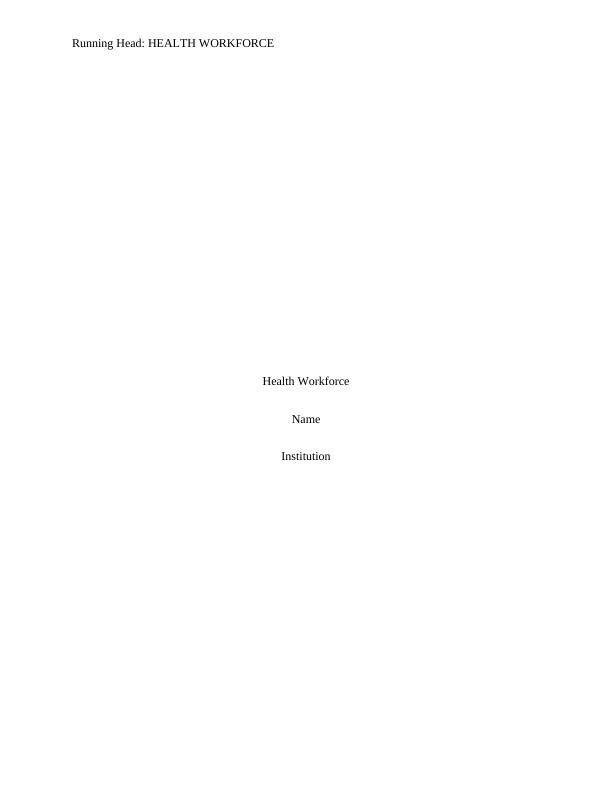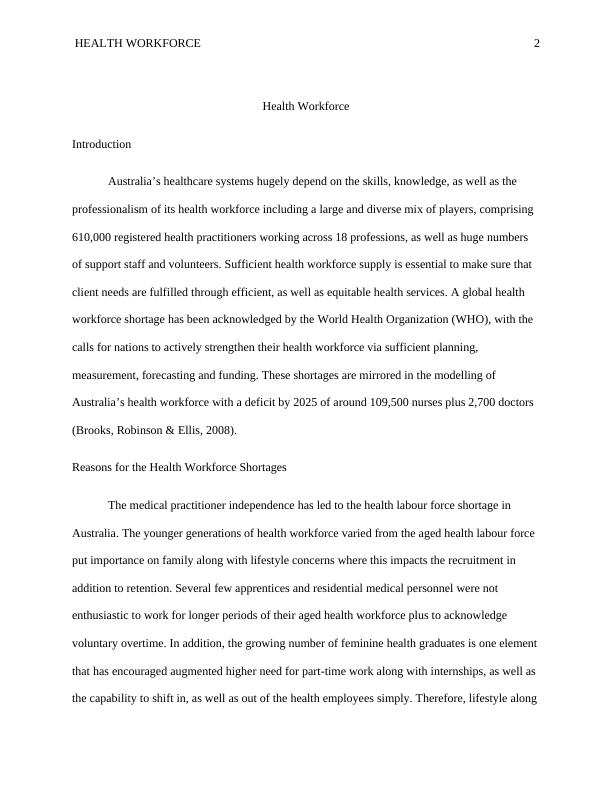Health Workforce: Shortages, Reasons, and Evidence-based Strategy
Added on 2023-06-08
6 Pages1135 Words163 Views
Running Head: HEALTH WORKFORCE
Health Workforce
Name
Institution
Health Workforce
Name
Institution

HEALTH WORKFORCE 2
Health Workforce
Introduction
Australia’s healthcare systems hugely depend on the skills, knowledge, as well as the
professionalism of its health workforce including a large and diverse mix of players, comprising
610,000 registered health practitioners working across 18 professions, as well as huge numbers
of support staff and volunteers. Sufficient health workforce supply is essential to make sure that
client needs are fulfilled through efficient, as well as equitable health services. A global health
workforce shortage has been acknowledged by the World Health Organization (WHO), with the
calls for nations to actively strengthen their health workforce via sufficient planning,
measurement, forecasting and funding. These shortages are mirrored in the modelling of
Australia’s health workforce with a deficit by 2025 of around 109,500 nurses plus 2,700 doctors
(Brooks, Robinson & Ellis, 2008).
Reasons for the Health Workforce Shortages
The medical practitioner independence has led to the health labour force shortage in
Australia. The younger generations of health workforce varied from the aged health labour force
put importance on family along with lifestyle concerns where this impacts the recruitment in
addition to retention. Several few apprentices and residential medical personnel were not
enthusiastic to work for longer periods of their aged health workforce plus to acknowledge
voluntary overtime. In addition, the growing number of feminine health graduates is one element
that has encouraged augmented higher need for part-time work along with internships, as well as
the capability to shift in, as well as out of the health employees simply. Therefore, lifestyle along
Health Workforce
Introduction
Australia’s healthcare systems hugely depend on the skills, knowledge, as well as the
professionalism of its health workforce including a large and diverse mix of players, comprising
610,000 registered health practitioners working across 18 professions, as well as huge numbers
of support staff and volunteers. Sufficient health workforce supply is essential to make sure that
client needs are fulfilled through efficient, as well as equitable health services. A global health
workforce shortage has been acknowledged by the World Health Organization (WHO), with the
calls for nations to actively strengthen their health workforce via sufficient planning,
measurement, forecasting and funding. These shortages are mirrored in the modelling of
Australia’s health workforce with a deficit by 2025 of around 109,500 nurses plus 2,700 doctors
(Brooks, Robinson & Ellis, 2008).
Reasons for the Health Workforce Shortages
The medical practitioner independence has led to the health labour force shortage in
Australia. The younger generations of health workforce varied from the aged health labour force
put importance on family along with lifestyle concerns where this impacts the recruitment in
addition to retention. Several few apprentices and residential medical personnel were not
enthusiastic to work for longer periods of their aged health workforce plus to acknowledge
voluntary overtime. In addition, the growing number of feminine health graduates is one element
that has encouraged augmented higher need for part-time work along with internships, as well as
the capability to shift in, as well as out of the health employees simply. Therefore, lifestyle along

HEALTH WORKFORCE 3
with working hours have been perceived as impacting the decision of training programs resulting
in health workforce shortages in some areas in Australia (Joyce, McNeil & Stoelwinder, 2006).
The geographical distribution of the health workforce has been linked to the shortage of
health experts in Australia. The remote plus rural areas in Australia have experienced critical
shortages of health workforce as compared to the metropolitan areas in the country. This has
been attributed to the migration or “brain drain” effect, where health professionals prefer to work
in metropolitan or urban areas rather than in rural or remote areas. Additionally, it has been
established that many healthcare professionals are leaving to other countries where they believe
that their welfare will be improved rather than working in Australia where they work for many
hours (Martineau, Decker & Bundred, 2004). This leaves no option for the country, but to use the
aged healthcare workforces who are not that effective. In addition, many healthcare workforces
are now migrating to the private sector creating a shortage of health experts in the public
segment.
The difficulty in recruiting and retaining new health workforce has been attributed to the
growing shortages in the healthcare sector in Australia. The challenge of retaining and recruiting
skilled and experienced healthcare workforce occurs both in the private and private sector and it
is forecast that this situation will worsen in the future. Founded on anecdotal evidence, around
75% of the nurses in hospital wards are currently talking about leaving. Many healthcare
facilities have reported that they have experienced a 30% turnover of healthcare workforce
annually. This has greatly affected the delivery of service in the country (Coomber & Barriball,
2007).
with working hours have been perceived as impacting the decision of training programs resulting
in health workforce shortages in some areas in Australia (Joyce, McNeil & Stoelwinder, 2006).
The geographical distribution of the health workforce has been linked to the shortage of
health experts in Australia. The remote plus rural areas in Australia have experienced critical
shortages of health workforce as compared to the metropolitan areas in the country. This has
been attributed to the migration or “brain drain” effect, where health professionals prefer to work
in metropolitan or urban areas rather than in rural or remote areas. Additionally, it has been
established that many healthcare professionals are leaving to other countries where they believe
that their welfare will be improved rather than working in Australia where they work for many
hours (Martineau, Decker & Bundred, 2004). This leaves no option for the country, but to use the
aged healthcare workforces who are not that effective. In addition, many healthcare workforces
are now migrating to the private sector creating a shortage of health experts in the public
segment.
The difficulty in recruiting and retaining new health workforce has been attributed to the
growing shortages in the healthcare sector in Australia. The challenge of retaining and recruiting
skilled and experienced healthcare workforce occurs both in the private and private sector and it
is forecast that this situation will worsen in the future. Founded on anecdotal evidence, around
75% of the nurses in hospital wards are currently talking about leaving. Many healthcare
facilities have reported that they have experienced a 30% turnover of healthcare workforce
annually. This has greatly affected the delivery of service in the country (Coomber & Barriball,
2007).

End of preview
Want to access all the pages? Upload your documents or become a member.
Related Documents
Health Work Force Planning in Australialg...
|10
|2681
|99
Shortage of ‘Nursing Practitioners’ in Australian Rural Arealg...
|12
|3428
|84
International Health Worker Immigration in Australialg...
|13
|2305
|28
Health Service Delivery in Rural and Remote Contextslg...
|14
|3675
|406
Economic Evolution in Healthcarelg...
|9
|2438
|23
Health Workforce in Australia: International Migration and Government Policieslg...
|9
|2247
|72
